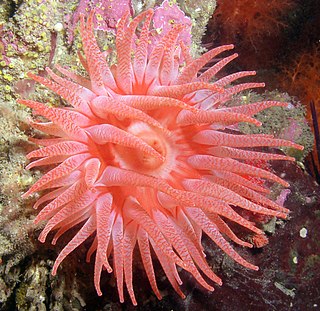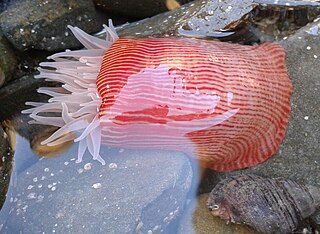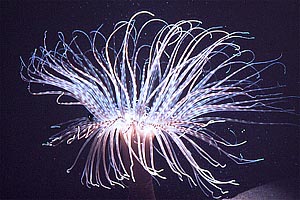
Actiniidae is the largest family of sea anemones, to which most common, temperate, shore species belong. Most members of this family do not participate in symbioses with fishes. Three exceptions are the bubble-tip anemone, snakelocks anemone and Urticina piscivora.

Cribrinopsis fernaldi, also known as the crimson anemone, snakelock anemone, chevron-tentacle anemone and Fernald brooding anemone, is a sea anemone native to the Pacific Ocean off northwestern North America.

Stichodactyla is a genus of sea anemones, of the family Stichodactylidae. They are host anemones, which maintain a relationship mutualistic with other animals, in their case with crabs of the genus Mithraculus, shrimp of the genus Periclimenes , and with various species of clownfish, of the genus Amphiprion, establishing a relationship of coexistence. In this way, crabs and fish protect themselves from their predators between the stinging tentacles of the anemone, and the anemone benefits from the cleaning of its oral disc and tentacles as a result of the continuous movements of the animals.

Sea anemones are a group of predatory marine invertebrates constituting the order Actiniaria. Because of their colourful appearance, they are named after the Anemone, a terrestrial flowering plant. Sea anemones are classified in the phylum Cnidaria, class Anthozoa, subclass Hexacorallia. As cnidarians, sea anemones are related to corals, jellyfish, tube-dwelling anemones, and Hydra. Unlike jellyfish, sea anemones do not have a medusa stage in their life cycle.

Hormathiidae is a family of sea anemones in the class Anthozoa.

Epiactis prolifera, the brooding, proliferating or small green anemone, is a species of marine invertebrate in the family Actiniidae. It is found in the north-eastern Pacific. It has a feature rare among animals in that all individuals start life as females but develop testes later in their lives to become hermaphrodites.

Liponema is a genus of sea anemones, in the family Liponematidae.

Haloclavidae is a family of sea anemones. Members of the family are found worldwide and many live largely buried in soft substrates with only their oral disc and tentacles protruding.

Peachia is a genus of sea anemone in the family Haloclavidae. Members of this genus typically burrow into soft substrates. The only part of the animal that is normally visible is the oral disc and tentacles which lie flat on the sand in a star shape. The type species is Peachia cylindrica.

Actinodendron arboreum, commonly known as tree anemone or hell's fire anemone, is a species of sea anemone in the family Actinodendronidae. It is native to the Indo-Pacific where it grows at depths of down to 28 metres (92 ft). Most sea anemone species are harmless to humans, but A. arboreum is highly venomous and its sting can cause severe skin ulcers.

Phlyctenanthus australis, commonly known as red anemone or southern anemone, is a species of sea anemone in the family Actiniidae. It grows to a maximum size of 10 cm in diameter. The column is red-brown in colour with blue vesicles covering it. The tentacles are reddish-brown and short, and number up to around 100. This species is found in south Australia, New South Wales, down to Tasmania. This species lives on exposed reefs at depths of between 1 and 35 metres.

The Enthemonae is a suborder of sea anemones in the order Actiniaria. It comprises those sea anemones with typical arrangement of mesenteries for actiniarians.

Epiactis thompsoni, the red-striped anemone, is a species of marine invertebrate in the family Actiniidae, found in New Zealand and South Australia. They are commonly found in the rocky intertidal zone.

Spirularia is an order of marine Cnidarians, tube-dwelling anemones, in the subclass Ceriantharia. It is one of the two orders making up Ceriantharia and includes two families, Botrucnidiferidae and Cerianthidae, and around 99 species. The two orders differ in the makeup of their cnidome, the relative sizes of the oral discs and the shape and structure of the mesenteries.

Gonactinia is a monotypic genus of sea anemones, and G. prolifera is the only species in the genus. It is sometimes called the storey anemone and is found on either side of the northern Atlantic Ocean.

Diadumene is a genus of sea anemones. It is the only genus in the monotypic family Diadumenidae.

Epiactis ritteri, the sandy anemone or Ritter's brooding anemone, is a species of sea anemone in the family Actiniidae. It is found in the Pacific Ocean on the western coast of North America in the shallow sub-littoral zone.

Epiactis lisbethae, commonly known as Lisbeth's brooding anemone, is a species of sea anemone in the family Actiniidae. It is similar in appearance to the common brooding anemone, and like it is native to shallow waters on the western coast of North America.
Epiactis fernaldi, commonly known as the Fernald brooding anemone, is a species of sea anemone in the family Actiniidae. It is native to shallow waters around the San Juan Islands off the western coast of North America.

Mesacmaea mitchellii is a species of sea anemone in the family Haloclavidae. It is found in the northeastern Atlantic Ocean and the Mediterranean Sea where it burrows in soft sediment.


















